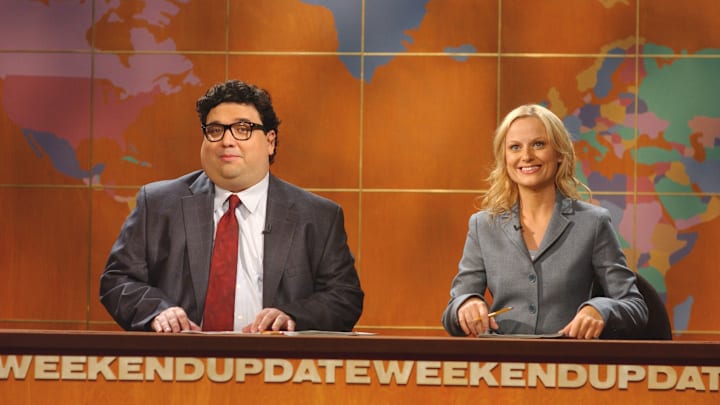If comedy was like a run for president, then the hallowed halls of Saturday Night Live would be the White House. After all, there’s no better route to instantaneous nationwide visibility than to become an SNL cast member.
But even when a comedian makes the cut, it’s not all puppies and rainbows. Julia Sweeney once said that being on Saturday Night Live was like "having an Uncle you hate paying for all four years of Harvard." And getting in, it probably goes without saying, is tough.
In his book Gasping for Airtime: Digging through the Trenches of Saturday Night Live, SNL alum Jay Mohr summed it up like this: "Thousands of students show up every year at the doors of Harvard, but how many people walk through the turnstiles each year at SNL? A dozen? How many of that dozen, if any, are new performers? Three? Four? Zero?”
With some exceptions—like during years of high turnover, when the show has imported well-known talent like Billy Crystal and Janeane Garofalo—Saturday Night Live usually hires talented up-and-comers to show business with little to no television and film experience. Take, for example, Abby Elliot. Prior to Saturday Night Live, her entire IMDb listing was five episodes of voice work on two animated TV shows, and a role in a TV movie (starring her father, SNL alum Chris Elliott) that never aired. The biggest star to come out of SNL in recent memory, Kristen Wiig, had just a handful of appearances on her resume.
So where exactly do all these talented actors come from?
SNL’s talent scouts find comedians primarily from four comedy clubs: Second City, which started in Chicago and migrated to Toronto, Hollywood, and Amsterdam (there’s also a traveling show); Improv Olympic in Chicago and Los Angeles; the UCB Theater in New York and LA; and the Groundlings in Los Angeles. There’s logic in this method: Someone working with one of those companies will already have tons of training and be a seasoned performer who can better handle all the rigors of being on a live TV show.
Throughout the year, the scouts invite promising prospects to a showcase with a live, paying audience, and evaluate the contender over the course of a 10-minute set that consists either of straight stand-up or a mix of celebrity impressions and original characters. And sometimes if the performer is in another city, they ask him to send in an audition tape. Some of these audition tapes, like Will Greenberg’s and Susan Deming’s, find their way to YouTube. There are no open auditions.
Can you get on the show by putting your reel up on YouTube?
Probably not. Most audition tapes that appear online are from comedians who have established themselves as live performers or were contacted through formal channels. Even Pharoah, whose YouTube videos caught the attention of SNL’s scouts, had been performing stand-up since he was 15.
There is one other notable exception, though, from the days before YouTube. When drummer Fred Armisen’s band Trenchmouth broke up in 1996, he became frustrated with the alternative music scene. So for the 1998 South by Southwest Music Festival, he made a guerilla video, "Fred Armisen's Guide to Music and SXSW.” It became one of the most bootlegged videos among music aficionados (today we'd call this "going viral") and, just a few years later, Armisen ended up on SNL.
How tough are the auditions?
We’ll let actor Rob Huebel, who had to wait seven hours and cut his material in half for his 2004 SNL audition, answer this one: "They really ice you out," he said. "They try to make it as scary as possible because it’s a live show, and in real life, I’m sure it is terrifying and things do go wrong, so they want you to be prepared." (Huebel wasn't selected for SNL, but he went on to a successful career in comedy on VH1's Best Week Ever, Comedy Central's The Human Giant, and the Oscar-winning film The Descendants.)
From Jimmy Fallon’s audition tape, you can tell that the audience is a pretty tough crowd. SNL creator Lorne Michaels has said that there were only two people who auditioned well enough that he was comfortable putting them on the air right then and there: Kristen Wiig and Dana Carvey.
What are some audition strategies that worked for famous SNL alums?
Many SNL cast members have used unorthodox audition techniques. For callbacks, Mohr decided to get really drunk—so drunk that when Michaels and talent agent Marci Klein came to congratulate him after the act, Mohr was too inebriated to engage them in conversation.
After being told that she wasn’t strong enough, Victoria Jackson used an appearance on The Tonight Show to impress Michaels. With Johnny Carson's permission, she told the audience that she was auditioning for SNL; then she performed various character impressions and challenged Carson to guess who they were. Michaels hired her soon thereafter.
Eddie Murphy got in the door through the most unconventional means imaginable. According to talent coordinator Neil Levy, Murphy called him daily, pleading for the chance to audition because he had 18 siblings counting on him to get a job. After a week of calls, Levy agreed to use him as an extra (the cast had already been hired). But when Levy went through Murphy’s screen test, he was so impressed that he went to producer Jean Doumanian and demanded that Murphy be hired.
